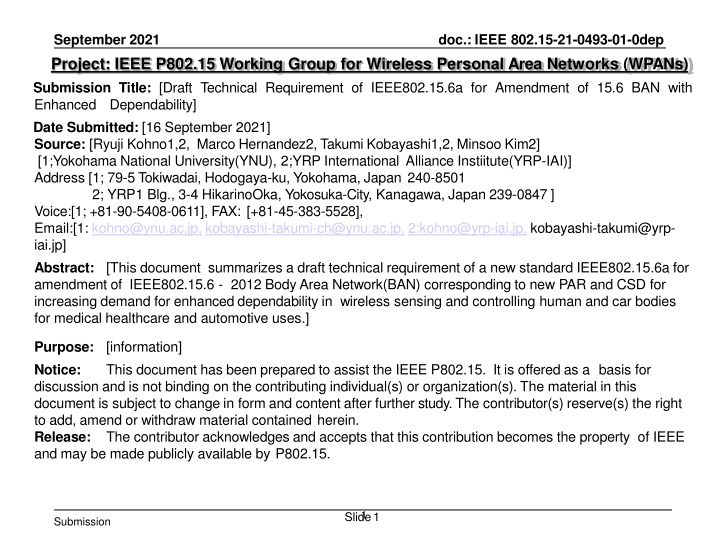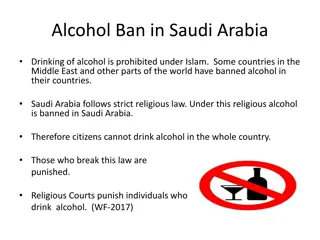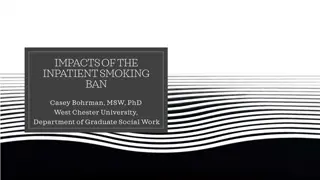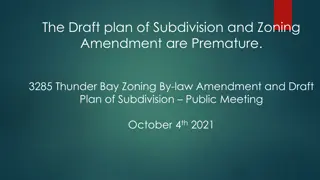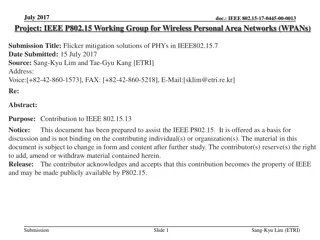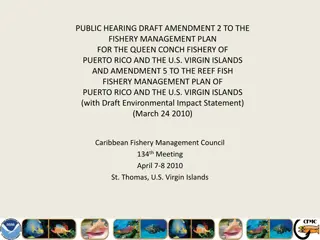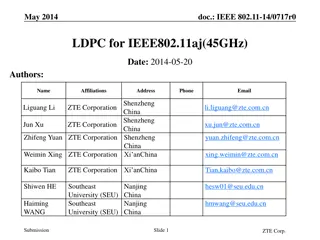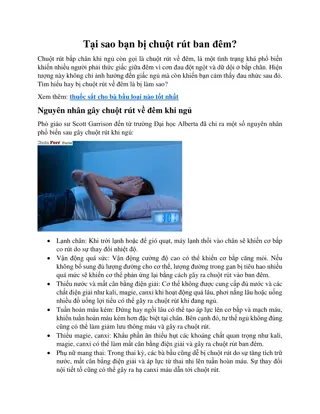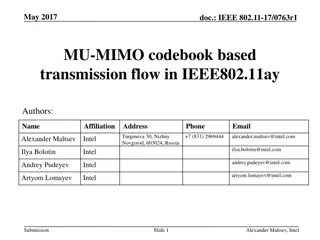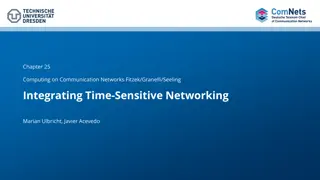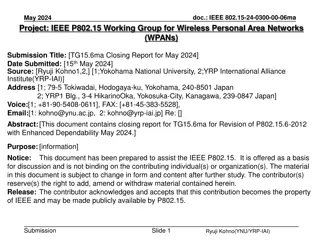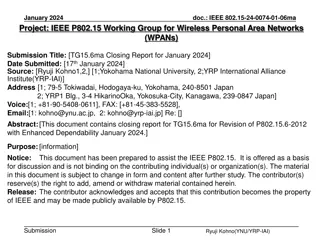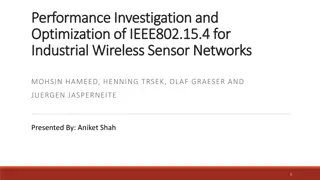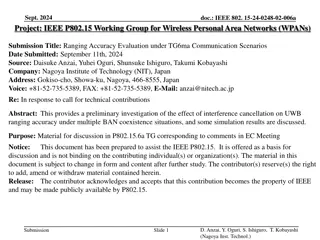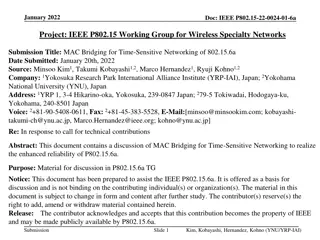Draft Technical Requirement of IEEE802.15.6a for Amendment of 15.6 BAN with Enhanced Dependability
This document summarizes the draft technical requirement of a new standard, IEEE802.15.6a, for amending IEEE802.15.6 related to Body Area Network (BAN) with enhanced dependability for medical healthcare and automotive applications. It addresses the necessity and uniqueness of the amendment, specified use cases for HBAN and VBAN, and the technical requirements for enhancing dependability in wireless sensing and control.
Uploaded on Apr 04, 2025 | 1 Views
Download Presentation

Please find below an Image/Link to download the presentation.
The content on the website is provided AS IS for your information and personal use only. It may not be sold, licensed, or shared on other websites without obtaining consent from the author.If you encounter any issues during the download, it is possible that the publisher has removed the file from their server.
You are allowed to download the files provided on this website for personal or commercial use, subject to the condition that they are used lawfully. All files are the property of their respective owners.
The content on the website is provided AS IS for your information and personal use only. It may not be sold, licensed, or shared on other websites without obtaining consent from the author.
E N D
Presentation Transcript
September 2021 Project: IEEE P802.15 Working Group for Wireless Personal Area Networks (WPANs) Submission Title: [Draft Technical Requirement of IEEE802.15.6a for Amendment of 15.6 BAN with Enhanced Dependability] Date Submitted: [16 September 2021] Source: [Ryuji Kohno1,2, Marco Hernandez2, Takumi Kobayashi1,2, Minsoo Kim2] [1;Yokohama National University(YNU), 2;YRP International Alliance Instiitute(YRP-IAI)] Address [1; 79-5 Tokiwadai, Hodogaya-ku, Yokohama, Japan 240-8501 2; YRP1 Blg., 3-4 HikarinoOka, Yokosuka-City, Kanagawa, Japan 239-0847 ] Voice:[1; +81-90-5408-0611], FAX: [+81-45-383-5528], Email:[1: kohno@ynu.ac.jp, kobayashi-takumi-ch@ynu.ac.jp, 2:kohno@yrp-iai.jp, kobayashi-takumi@yrp- iai.jp] Abstract: [This document summarizes a draft technical requirement of a new standard IEEE802.15.6a for amendment of IEEE802.15.6 - 2012 Body Area Network(BAN) corresponding to new PAR and CSD for increasing demand for enhanced dependability in wireless sensing and controlling human and car bodies for medical healthcare and automotive uses.] doc.: IEEE 802.15-21-0493-01-0dep Purpose: [information] Notice: This document has been prepared to assist the IEEE P802.15. It is offered as a basis for discussion and is not binding on the contributing individual(s) or organization(s). The material in this document is subject to change in form and content after further study. The contributor(s) reserve(s) the right to add, amend or withdraw material contained herein. Release: The contributor acknowledges and accepts that this contribution becomes the property of IEEE and may be made publicly available by P802.15. 1 Slide1 Submission
doc.: IEEE 802.15-21-0493-01-dep September 2021 Draft Technical Requirement of IEEE802.15.6a for Amendment of 15.6 BAN with Enhanced Dependability Ryuji Kohno1,2, Marco Hernandez2, Takumi Kobayashi1,2, Minsoo Kim2 1 Yokohama National University,Japan(YNU) 2 YRP International Alliance Institute,Japan(YRP-IAI) Submission R.Kohno,M.Hernandez,T.Kobayashi,M.Kim(YNU/YRP-IAI) Slide2
doc.: IEEE 802.15-21-0493-01-0dep September2021 Agenda 1. Necessity and Uniqueness for Amendment of BAN with Enhanced Dependability 2. Specified Use Cases for HBAN and VBAN with Channel and Environment Models 3. Technical Requirement for the Amendment of Std. 15.6 to Enhance Dependability Submission Submission R.Kohno,M.Hernandez,T.Kobayashi,M.Kim(YNU/YRP-IAI) Slide3
doc.: IEEE 802.15-21-0493-01-0dep September 2021 2. Technical Requirement of IEEE802.15.6a for the Amendment of Std. 15.6 to Enhance Dependability Submission Submission R.Kohno,M.Hernandez,T.Kobayashi,M.Kim R.Kohno,M.Hernandez,T.Kobayashi,M.Kim(YNU/YRP (YNU/YRP- -IAI) IAI) Slide 4
doc.: IEEE 802.15-21-0493-01-0dep September 2021 1.1 Necessity for Enhanced Dependability in std 15.6 BAN 1. In case of coexistence of multipleBANs Current existing standard IEEE802.15.6 has not been designed to manage contention and interference among overlaid BANs. The more BAN uses indense area, the more contention and inference cause performancedegradation. Amendment of PHY and MAC for resolving these problems in coexistenceof BANs is necessary. 2. In case of coexistence with otherradios For enhanced dependability, UWB PHY of BAN should be updated to avoid performance degradation due to interference with coexisting other narrowband and UWB networks in overlapped frequencyband. 3. In case of feedback sensing and controllingloop Remote medical diagnosis with vital sensing and therapy and controlactuators and robotics need more dependable and efficientprotocol. 4. Usability and Implementation Complexity Interoperability with other radio networks, more flexible network topology, Transparency with other standards such as ETSISmartBAN Capability of ranging and positioning in UWB is required for mobility and security. Submission R.Kohno,M.Hernandez,T.Kobayashi,M.Kim(YNU/YRP-IAI) 5
doc.: IEEE 802.15-21-0493-01-0dep September 2021 1.2 Technical Challenges for Enhanced Dependability First of all, we should recognize that any technology in PHY and MAC cannot guarantee full dependability in every use case. However, we can design a new standard which can guarantee a certain level of enhanced dependability in a specific defined use case. As an analogy of informed consent in medical doctor to a patient, a manufacturer of a dependable wireless network can describe such a specific defined use case that the manufacture can guarantee a defined level of dependability showing necessary cost and remained uncertainty. This is an honest manner and much better than no guarantee for any use case. Therefore, an expecting standard describes a specific use case in which worst performance can be guaranteed enough high while most of exiting standards have been designed with average performance base. Technical requirement for the specific use case can be guaranteed. Submission Submission R.Kohno,M.Hernandez,T.Kobayashi,M.Kim(YNU/YRP-IAI) Slide6
doc.: IEEE 802.15-21-0493-01-0dep September 2021 1.3 Uniqueness different from existing standards (1/2) 1. MAC protocol for around packets and recursive access for feedback loop in remote sensing andcontrolling; 2. Level of dependability can be defined with showing necessary cost and remained uncertainty. This is an honest manner and much better than no guarantee for any use case. 3. Worst performance can be guaranteed enough high while most of exiting standards have been designed with average performance base. 4. Others Submission R.Kohno,M.Hernandez,T.Kobayashi,M.Kim(YNU/YRP-IAI) Slide7
doc.: IEEE 802.15-21-0493-01-0dep September 2021 1.3 Uniqueness different from existing standards (2/2) 2.PHY enhanced dependability in the focused use cases A) In feedback loop for remote monitoring sensors or radars and feedback controlling actuators, real-time cognition of varying condition on site and adaptive reconfiguration in relatively messy, small, and dense areas are requested to guarantee worst performance with permissible delay and errors. B) Within a permissible limited feedback delay, propagation paths connecting between nodes and coordinator should be found to keep connectivity by diversity, channel switching etc. . C) For such a dynamic environment and QoS requirement changing situation, sophisticated requested to guarantee minimum requirement of performance. technologies to satisfy technical requirement for PHY technologies are R.Kohno,M.Hernandez,T.Kobayashi,M.Kim(YNU/YRP-IAI) Submission
doc.: IEEE 802.15-21-0493-01-0dep September 2021 1.4 Focused Issues inAmendment of std 15.6 BAN with EnhancedDependability 1. MAC Protocol in case of coexistence of multiple BANs Amendment of MAC for resolving these problems in coexistence of BANs is necessary. Specified MAC protocol for feedback sensing and control loopbetween coordinator and nodes. 2. PHY Interference Mitigation In case of coexistence with other radios For enhanced dependability, UWB PHY of BAN should be updated to avoid performance degradation due to interference with coexisting other narrowband and UWB networks in overlapped frequencyband. 3. Usability and Implementation Complexity Interoperability with narrow band and UWBPHY more flexible network topology, Transparency with other standards such as ETSISmartBAN 4. Ranging and Positioning Capability of UWB-BAN Mobile nodes and coordinator of BAN need ranging and positioning ofUWB-BAN Submission R.Kohno,M.Hernandez,T.Kobayashi,M.Kim(YNU/YRP-IAI)
doc.: IEEE 802.15-21-0493-01-0dep September 2021 2. Specified Use Cases for HBAN and VBAN with Channel and Environment Models Submission Submission R.Kohno,M.Hernandez,T.Kobayashi,M.Kim R.Kohno,M.Hernandez,T.Kobayashi,M.Kim(YNU/YRP (YNU/YRP- -IAI) IAI) Slide 10
September 2021 doc.: IEEE 802.15-21-0493-01-0dep 2.1 Proposed applications 1. Remote healthcare monitoring 2. Remote sensing and controlling 3. Vehicle internal sensing and controlling 4. Collision avoidance radar 5. Inter-vehicle communications and ranging 6. Wearable and implant wireless medical sensing and controlling 7. Applications for ultra wideband radio 8. Reliable and robust radio control 9. Wearable healthcare sensing 10. Secure remote healthcare and medicine 11. Wireless sensing system for Factory with feedback control 12. Dependable multi-hop inter-vehicle communications 13. Inter-navigation and inter-vehicle information sharing in normal and emergency conditions 14. Single wireless communication network solution that functions both in normal and in disaster environments 15. Disaster prevention, emergency rescue and recovery Slide 11 Submission T.Kobayashi, M.Kim, M. Hernandez, R.Kohno (YNU/YRP-IAI)
September 2021 doc.: IEEE 802.15-21-0493-01-0dep 2.2 Visualizing Portfolio of Focused Applications Highly Life Critical Uses(High QoS) Remote Diagnosis for Factory Automation Hospital Clinical Service Government Infrastructure Internal Car Dependable M2M Home Medical Therapy Inter-Vehicle M2M Life Line Remote Wellness & Well-being (Water/Gas/Electricity Supply) Inter-Vehicle M2M Industrial & Governmental Uses Home & Consumer Uses Public Safety Remote Diagnose s of Infra(bridge/bldg./train) Fitness, Massage & Sauna Sports: Walking, Jogging, Bicycling, Hiking, Skiing etc Disaster Analysis & Prevention Remote Sensing & Controlling Mobile Robots Less Life Critical Uses(Low QoS) Slide 12 Submission T.Kobayashi, M.Kim, M. Hernandez, R.Kohno (YNU/YRP-IAI)
September 2021 doc.: IEEE 802.15-21-0493-01-0dep 2.3 Three Classes of Focused Potential Applications We have classified focused potential applications into three classes according to demands of dependability. QoS 1 Class: Highest Priority Level for Demand of Dependability 1.1 Car Internal M2M 1.3 Remote Diagnosis in Factory 2.3 Professional Medicine 3.2 Public Safety QoS 2 Class: Meddle Priority Level for Demand of Dependability 1,2 Inter-vehicle M2M 2.2 Healthcare 3.1 Life Line (Water/Gas/Electricity Supply) 4.1 Remote Diagnosis of Infra(bridge/bldg./train) QoS 3 Class: Low Priority Level for Demand of Dependability 2.1 Wellness, Wellbeing 3.3 Government System 4.2 Remote Sensing and Controlling Mobile Robots 4.3 Disaster Analysis and Prevention Submission Slide 13
September 2021 doc.: IEEE 802.15-21-0493-01-0dep 2.4 Channel models and scenarios in IEEE802.15.6-2012 for Human BAN(HBAN) IEEE P802.15-08-0780-12-0006-TG6 IEEE 802.15.6-2012 channel models considered Fading ( Small scale/ large scale) Path loss Shadowing Power delay profile In-body (implant) On-body (body surface) CM1, 2, 3, 4 Scenario 1, to Scenario 7. (S1 S7) Submission Slide 14 T.Kobayashi, M.Kim, M. Hernandez, R.Kohno (YNU/YRP-IAI)
September 2021 2.5 Classification of Channel and Environment Models for Human and Vehicle Body Area Networks (HBAN&VBAN) Channel model On-body Around body not covered yet Channel model With environ ment doc.: IEEE 802.15-21-0493-01-0dep Covered by IEEE 802.15.6-2012 HBAN model In-body (Implant) Around meaning; Desk, WiFi AP in the room etc. Outdoor Indoor Home Office Medical (e.g. Hospital) VBAN model In-vehicle Engine room Cabin Through engine room and cabin mandatory Note: HBAN-model: -Environment with co-existing systems is not considered. On-vehicle Around vehicle Roof Side Right/Left/Front/back Bottom Static vehicle Moving vehicle VBAN model: Key-less entry system Localization in-body, on-body Most dominant model should be defined and separatory defined as Mandatory and Optional. mandatory mandatory 15 Submission T.Kobayashi, M.Kim, M. Hernandez, R.Kohno (YNU/YRP-IAI)
September 2021 2.6 Channel and Environmental Models doc.: IEEE 802.15-21-0493-01-0dep will be defined in this amendment Environment model Channel model Environment model Channel model 1. Path loss 2. Reflection 3. Multipath 4. Fading 5. LOS / NLOS model 6. White Gaussian noise IEEE802.15.6-2012 Other wireless systems EMI EMC Time-varying modeling Colored noise 7. Interference from co-existing wireless systems e.g. Bluetooth, IEEE 802.11, IEEE 802.15.4 etc. 8. Interference from the other BANs. 9. Interference from the other electric systems, devices and components (Electro-magnetic interference; EMI from electric motors, spark plugs in vehicles, etc. 10. Electro-magnetic compatibility; EMC. Possibility to affect to the other systems and human body. 11. VBAN HBAN interference 12. VBAN and HBAN Vehicle control and human body impacts. 13. Colored noise (Impulse noise, spike noise, ignition noise etc.) 14. Time-varying channel and interference modeling (Statistic, non-static, pseudo static model) mandatory optional mandatory mandatory Comments in May 2021. optional or ? mandatory or ? mandatory optional mandatory optional Submission Slide 16 T.Kobayashi, M.Kim, M. Hernandez, R.Kohno (YNU/YRP-IAI)
doc.: IEEE 802.15-21-0023-02-0dep September2021 3. Technical Requirement of IEEE802.15.6a for the Amendment of Std. 15.6 to Enhance Dependability Submission R.Kohno,M.Hernandez,T.Kobayashi,M.Kim R.Kohno,M.Hernandez,T.Kobayashi,M.Kim(YNU/YRP (YNU/YRP- -IAI) IAI) Slide 17
September 2021 doc.: IEEE 802.15-21-0493-01-0dep 3.1 Update of Technical Requirements for IEEE802.15.6a, Amendment of BAN - After PAR and CSD are approved by NesCom on Sept. 22nd, the technical requirement should be officially defined. - According to the new PAR and CSD, the technical requirement should be considered corresponding to focused use cases. - To evaluate expected performance of new HBAN and VBAN, channel and environment models are used. R.Kohno,M.Hernandez,T.Kobayashi,M.Kim(YNU/YRP-IAI) Submission Slide 18
September 2021 doc.: IEEE 802.15-21-0493-01-0dep 3.1 Update of Technical Requirements for IEEE802.15.6a, Amendment of BAN - IEEE802.15.6 for Medical BAN was established in Feb. 2012 and has not been updated for successive applications. - IG-DEP has been discussing with ETSI Smart BAN for digital healthcare and further medical applications. - NICT Brain Machine Interface; BMI labs with medical community requests amendment of IEEE802.15.6 for much higher capacity and reliability in IG-DEP, particularly 2nd Generation of ECoG with much more electrodes beyond EEG using UWB technologies. - IG-DEP has decided to include dependable medical BAN with higher capacity and reliability in focused applications. - Then updated technical requirement has been discussed. - The updated requirement will be summarized in next pages. R.Kohno,M.Hernandez,T.Kobayashi,M.Kim(YNU/YRP-IAI) Submission Slide 19
doc.: IEEE 802.15-21-0023-02-0dep September 2021 3.2 Updated Technical Requirements(1/5) Car Factor y automa tion Upto ten per netw ork High Data Rate BAN (HRP) Low Data Rate BAN (LRP) UAV(Dron e)Sensing &Control Dependable BAN including Car Body as well as Human and Robotic Body Reference standard 802.15.6 Number of sensors 128, 64, 32, 16, 8, 4, 2 nodes foreach unit. In case of Human body,4 unitscan cover 256 nodes as the same as 15.6. In case of Car body, M>4 units cancover 64xM nodes in layerstructure. Class A; node transmittingperiodical packets Class B: node doing non-periodicalones. Less than 64 units. 1 unit contains 64 sensors. Includes multiple BANs overlaid. Other choices are 32 nodes/unit and max no. of units is100 Ref. 64 sensors x 64 Units = 4,096 sensors that is sufficient for 2nd G ECoGBMI Star +multiple hop or Star + mesh Due to relationship with smartBAN and smart M2M Two layered clustertree 2 Mbps For high QoS(priority) packets, 1Mbps while shorter back-off time or delay For low QoS packets, 2 Mbps or higher while permissible delaylonger Up to ten per network 256 For 2ndG ECoG BMI 128x32,64x64 32x128, 16x256,8x512 4x1024. 2x2048 Up to ten (ex. camera, GPS etc.) Up to4096 Up to256 0 Not expected multiple BANs overlaid Up to ten (ex. at least 4 dronesfor relative localization) Less than 100 Up to 100 Up to3 BANs Support for multiple networkco- existence& interoperab ility Single Topology Star(dynami c allocation of coordinator) Up to severalten Mbps/cam era/drone Exten ded star Star + bus Star+multi hop (extended) star+one hop Star(2pairs) Data rate 1 Mbps for narrow 11 Mbps UWB in max Com parab le to CAN, RIM Up to 1KHzx12 =12kbps/se nsor Aggregate rate up to 2Mbps 2 Mbps/s e nsor Band for Submission R.Kohno,M.Hernandez,T.Kobayashi,M.Kim(YNU/YRP R.Kohno,M.Hernandez,T.Kobayashi,M.Kim(YNU/YRP- -IAI) IAI) Slide 20
doc.: IEEE 802.15-21-0023-02-0dep September 2021 3.2 Updated Technical Requirements(2/5) Factory automation Car DependableBAN for Car Body as well as Human Body 6 hundred Mbps in case of 4 nits x 64 nodes/unit Ref. Satisfying 49Mbps for2nd G ECoGBMI UAV(Drone) Sensing & Controlling High Data Rate BAN (HRP) Low Data Rate BAN (LRP) Reference standard 802.15.6 Aggregate data rateover interoperating networks 50Mbps 2Mbps N/A Few hundred Mbps Up to1 Gbps Up toseveral Mbps/drone Typical 50to 100 ms Ref.15.4e Latencyin normal operation 250 ms to 1s 250 ms to 500 ms Frame length 10-20ms Latency 10ms 10 ms to 20ms 250 ms to1s Ref. to beconsidered use case of 2nd G ECoGBMI Comparab le to CAN, RIM or FlexRay Latencyin critical situation Few ms to 15 ms * Several 10ms 5-10ms 10ms Less than typicalcase 100ms Ref. to beconsidered use case of 2nd G ECoGBMI < 1s Ref. to beconsidered use case of 2nd G ECoGBMI < 1s Ref. to beconsidered use case of 2nd G ECoGBMI Comparab le to CAN, RIM or FlexRay Association delay < 1s <100ms Same direction< 30ms < 60ms Less than1s Optional requirement N/A Authenticatio n andsecurity delay < 1s N/A Same direction< 50ms < 100ms Seconds Optional requirement N/A Deliveryratio requirement *Reference: > 99.9% > 99% > 99.9% > 99.9% > 99% >95% Ref. to be considered use case of 2nd GBMI 95% Factory Auto mation criticall usage-part1-0317-v00.pdf &new-itaya-general-industrial-usage-part2-0317-v00.pdf atency: FFPJ docs n ew-maruhashi-ge neral-industrial- Submission R.Kohno,M.Hernandez,T.Kobayashi,M.Kim(YNU/YRP-IAI) Slide 21
doc.: IEEE 802.15-21-0023-02-0dep September 2021 3.2 Updated Technical Requirements(3/5) Reference standard 802.15.6 Factory automation High Data Rate BAN (HRP) Low DataRate BAN (LRP) Car DependableBAN including Car Body as well as Human Body UA V(Drone) Sensing & Controlling Disconnection ratio (oftime) < 0.01% < 0.01% < 0.001% < 0.01% <2% <1% to be considereduse case of 2nd G ECoG BMI ? Synchronizati on recovery time < 100ms < 100ms < 70ms < 10ms N/A < 50ms to be considereduse case of 2nd G ECoG BMI Seconds Coverage range 6m 5m 100m(among drones)some km(with controller) 10cm 50cm < 10m Much lesscoverage for 2nd G ECoGBMI < 10m Feedback loopresponse time < 10ms < 1s < 10ms <10ms <100ms < 50ms Ref. to be considered use case of 2nd G ECoGBMI < 500ms N/A < 2s N/A N/A Not defined N/A N/A Handover capability CAN& RIM compatibil ity 10 to 1000 bytes 802.11 compatible 802.11 compatible 802.11 compatible Up to 255octets Datapacket size Up to 255 octets Submission R.Kohno,M.Hernandez,T.Kobayashi,M.Kim(YNU/YRP-IAI) Slide 22
doc.: IEEE 802.15-21-0023-02-0dep September 2021 3.2 Updated Technical Requirements(4/5) Car Factory automation Sensing & Controlling (HRP) High Data Rate BAN Low DataRate BAN (LRP) Dependable BAN including Car Body as well as Human Body UA V(Drone) Reference standard 802.15.6 QoS dependen t QoS dependen t 5ms 50 ms N/A N/A N/A Jitter: typical max Dependenton HighestQoS 5ms 5ms N/A N/A N/A Jitter:critical max: 5% outliers acceptable Dependenton HighestQoS Up to 3 BANs according to coveringrange <50 according to coverage range <10 according to no. ofdrones cluster <64 Ref. to be considered use case of 2nd G ECoGBMI By a few use casemodels, worst interference can be defined MultiBAN Overlaid (A) Intra network interference Driver/P asseng ers room: <10 Single(2pairs) according to spacing betweenBANs Engine room: <10 implant wearable single Corresponding for interference mitigation technologies Different PANs (B) Inter network interference (number of coexisting networks) Driver/P asseng ers room: < 5 Up to 3 PANS Corresponding to specification of coexisting PANs By a few use casemodels, worst interference can be defined. <10 according to factory condition <5 according to no. ofdrones cluster <10 Ref. to be considered use case of 2nd G ECoGBMI Submission R.Kohno,M.Hernandez,T.Kobayashi,M.Kim(YNU/YRP-IAI) Slide 23
doc.: IEEE 802.15-21-0023-02-0dep September2021 3.2 Updated Technical Requirements(5/5) High Data Rate BAN (HRP) Low DataRate BAN (LRP) Car Factory automation Reference standard 802.15.6 UAV(Drone) Remote Sensing and Controlling Dependable BAN Channel model resilience Driver/Pass engers room: Light multipath Heavy multipathwith shadowing Line ofsight (LOS) Dedicated short distance (DSRC)with line of sight (LOS) No Line ofsight (NLOS) with shadowing and multipath Dependent on Highest QoS Ref. to be By a few use casemodels, worst interference can be defined considered use caseof 2nd G ECoG BMI Compliance for safety guide line with SAR & EMC Engine room: Heavy multipath with shadowing No Line of sight (NLOS) usingcamera Compliance for safety guide line with SAR & EMC Submission R.Kohno,M.Hernandez,T.Kobayashi,M.Kim(YNU/YRP-IAI) Slide 24
doc.: IEEE 802.15-21-0493-01-0dep 3.3 More Functional requirements (1) Throughput measured at MAC SAP (2) Transmission range (3) Transmission reliability (4) Connection to infrastructure (5) Bands of Operation (6) Positioning (7) Coexistence and interoperability (8) Privacy and security (9) Others 25 Submission R.Kohno,M.Hernandez,T.Kobayashi,M.Kim(YNU/YRP-IAI)
doc.: IEEE 802.15-21-0493-01-0dep September2021 4. Concluding Remark Corresponding request from ETSI smart BAN and smart M2M, IG-DEP and its successive SG15.6a have discussed to focus on internal car network for IoT/M2M connections that is focused on BAN for human and car bodies. As amendment of IEEE802.15.6, MAC for multiple BANs can be guaranteed to satisfy permissible delay or back-off time and throughput of high QoS packets for human and vehicle BANs while maintaining average performance. As amendment of IEEE802.15.6, PHY for UWB radios should be revised for updated UWB regulation. In particular, coexistence among different UWB radios of IEEE802.15 such as 15.4a, 15.4f, 15.4z can be supported. For instance, during CCA, types or features of these UWB radios can be analyzed to control access of packets from each radio. To include new use cases with enhanced dependability such as the 2nd Generation of ECoG for Brain-Machine-Interface(BMI), technical requirement has been updated to cover higher data rate and more units of ECoG sensors . We focus on amendment of IEEE802.15.6 for enhanced dependability in PHY and MAC and move on TG to complete the amendment. If you have any question and comment, you are welcome to discussion in SG15.6a and send content contributions to Ryuji Kohno <kohno@ynu.ac.jp> and Takumi Kobayashi <Kobayashi-takumi- ch@ynu.ac.jp> R.Kohno,M.Hernandez,T.Kobayashi,M.Kim(YNU/YRP-IAI) Submission Slide 26
